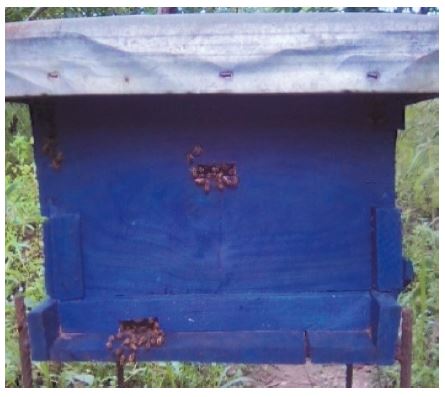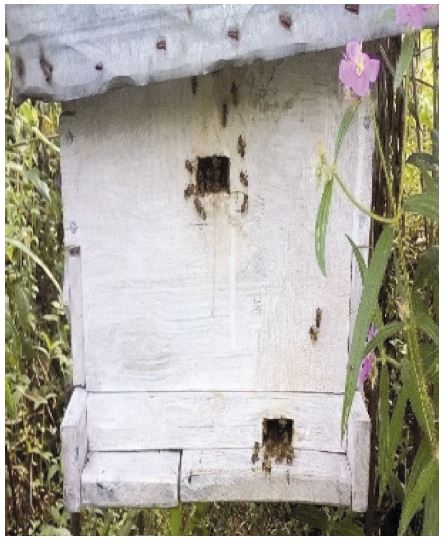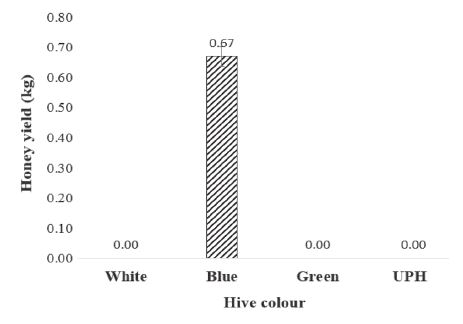
Assessment on Colonization, Absconding and Honey Yield by African Honeybee Colonies Reared in Hives with Different Colours in Awka, South-Eastern Nigeria
Abstract
Honey production in Nigeria is affected by several factors especially the inability to select the best hive colour. This research was conducted using twelve (12) modified top bar hives painted with different colours and labelled PH1, PH2, PH3 and UPH. The hive labelled PH1 was painted white, PH2 was painted royal blue while PH3 was painted mint green. However, hives labelled UPH used as control were unpainted hives constructed with Nauclea diderrichii. Each hive treatment was replicated three times in a Complete Randomized Design. Data collected were subjected to Kruskal-Wallis Test of significance. Treatment UPH had the highest colonization rate (100%), followed by treatment PH1 (66.7%) while least in hives painted with royal blue and mint green (33.33%). Colonization was observed in treatment PH1 and PH3 on August while it occurred in treatment UPH on July, August and September, 2017. No significant difference existed between the colonization rate of the different hive colours (P>0.05). Highest rate (100%) of absconding was recorded in treatment PH3. Treatment PH1, PH3 and UPH absconded in the months of November and October, 2017 and February, 2018 respectively. There was no significant difference in the absconding rate between the different hive colours. Importantly, honeybee colony in PH2 produced the highest quantity of honey (0.67 kg) while no honey (0.00kg) was harvested from the other treatments. Colour does not significantly influence hive colonization by African honeybees (P>0.05). The study concluded that hive colour did not significantly improve colonization, absconding and honey yield.
Keywords:
African honeybee, Hive colours, Honey production, Bee rearing, AwkaINTRODUCTION
Honey is the natural sweet substance produced by honeybees when processing the nectar of plants. The bees collect, deposit, and store the honey in the honeycombs to mature (Stefan and Martin, 2002). It is a solution of sugars (fructose and glucose), vitamins, minerals and pollens together with small amounts of miscellaneous compounds (Igwe et al., 2012). USDA (2013) described honey as a mixture of different compounds including sugars mainly fructose and glucose and other carbohydrates, water, trace number of vitamins and minerals and other compounds. Folayan et al. (2013) reported that honey is produced by honeybee workers mainly from the nectar of flower or honey dew on leaves and bark of trees. Thus, honey is defined as “the nectar saccharine exudation of plants” gathered, modified and stored as honey in the comb by African honeybees (Apis mellifera adansonii).
The business of beekeeping is seen rightly as a liable key in reducing poverty and malnutrition by creating jobs particularly for the unemployed youths and poor rural population (Famuyide et al., 2014). The production of honey through beekeeping has becoming popular among small scale farmers. This is because farmers have resorted to making income in diverse ways (Olarinde et al., 2008).
The rate at which people consume honey and utilize hive products in the world have greatly increased and improved with greater awareness (Akunne, 2015). The values of honey are too numerous for food security and good health which have called for a concerted effort on boosting honey production (Olagunju, 2000). Inability to increase the supply of honey and other bee hive products is rested upon several factors among which include wrong selection of suitable colour for the hives (Adedeji et al., 2014), insufficient management practice, lack of adequate beekeeping training and poor design of modern beehives (Ononye and Akunne, 2017). In addition, Kiemi et al. (2015) observed that absconding and low hive colonization are also one of the world problems in the beekeeping sector. The paucity of information on the influence of hive colours on performance of African honeybee colonies in Awka, South-eastern Nigeria necessitated this study.
MATERIALS AND METHODS
1. Study Area
The experiments were carried out in the Honeybee Research Centre of the Department of Zoology, Nnamdi Azikiwe University, Awka from July, 2017 to February, 2018. Awka lies within coordinates 6°12ʹN and 7°04ʹE (Akunne et al., 2016). Awka is in the tropical rain forest zone of Nigeria and experience two distinct seasons - wet and dry seasons. These two seasons are brought about by the two major winds that rule the area: the south-western monsoon winds from the Atlantic Ocean and the Northeast dry winds from across the Sahara Desert. The monsoon winds from the Atlantic create seven months of heavy tropical rains with average minimum rain fall of 1000 mm and maximum rain fall of 3200 mm (National Statistical Book, 1998) which occur between April and October and are followed by five months of dryness (November ~ March). The Harmattan has dry and dusty wind which enters the area in late December to January and is characterized by a grey haze limiting visibility and blocking the sun’s rays (NSB, 2010). The temperature in the study area is generally 27~30℃ between June and December but rises to 32~34℃ between January and April, with the month of March experiencing the hottest temperature 36~38℃. The relative humidity in the wet season is 82.37% and 74.25% in the dry season (NSB, 2010).
2. Description of the Experimental Site
The Honeybee Research Centre of the Department of Zoology lies within 291046.427°E, 691554.263°N (Akunne et al., 2016c). It is located along the road connecting the university primary school to the Faculty of Management sciences of the Nnamdi Azikiwe University, Awka.
The species of the flora present at the experimental site include Acassia spp (DC), Talinum triangulare (Jacq.), Pegolettia senegalensis (Cass.), Ageratum conyzoides (Linn.), Aspilia africana (Pers.), Tridax procumbens (Linn.), Vernonia cinerea (L.), Sida acuta (Burm. F.), Harungana madagascariensis (Lam. ex Poir.), Platostomab africanum (P. Beauv.), Pennisetum purpureum (Schumach). Arable crops within the location included Manihot esculenta (Crantz), Elaeis guineensis (Jacq.), Zea mays (L.), Abelmoschus esculentus, Musa sapientum (L.), Cucumis sativum (L.).
3. Experimental Design
The timber boards used for the hive construction were piled with spacers in well aerated timber shed to dry for a period of four months (Mbobua, 2013). Each hive comprised the bottom board (length=53.34 cm, width=35.56 cm), main cover board (length=55.88 cm, width=38.1 cm), brood chamber (length=52.07 cm, width=36.83 cm, depth=24.9 cm). Each hive consists of 8 top bars of 2 cm width and hive entrance (s) of 4×1 cm with a bee space of 2 mm between the top bars (Ononye, 2018). The main cover board was made of wood covered with corrugated iron sheets. Each hive had two flight entrances on the middle of the hive wall and the right edge of the hive floor (Ononye and Akunne, 2017).
Each of the hives was cleaned and baited. Forty grams (40 g) of beeswax was melted and used to bait each treatment. The molten beeswax was smeared on the hive entrances, top bars and the main cover boards of the hives with the aid of a brush. The baiting process was done between 6:00am~8:00am. The hives were allowed to dry after which the hives were installed (Ande et al., 2008). The baited hives were installed at the Honeybee Research Centre (HBRC) on a metallic stand (46 cm high) close to a tree as shade to avoid direct effect of sun. The hives were randomly mounted 10 m apart from each other while the flight entrances of hives were faced East (Babarinde et al., 2012; Ononye and Akunne, 2017). During this experiment, the hives environment was kept clean before and after colonization (Adedeji et al., 2014).
Twelve (12) modified top bar hives were painted with white, royal blue and mint green paints which were applied on the external surface of nine hives using brush, while the remaining six hives were unpainted. Four (4) litres of each of different colours of paint were used for this study. The Blue paint (Daetex Gloss plant) was purchased from Ibeme Nigeria Limited under the authority of C.C. I Nig. Ltd. During the painting, the flight entrances were blocked with foam to prevent the paints from touching the internal surface of the hives. The painted hives were allowed to dry for one week before installation. Based on hive colours, the top bar hives were labelled PH1, PH2 and PH3. The unpainted hives constructed with N. diderrichii were labelled UPH. The hive labelled PH1 was painted white (oil paint Ibeme), PH2 was painted royal blue (oil paint Ibeme), and PH3 was painted mint green (emulsion paint Kletex). However, hives labelled UPH1 served as the control. Each hive treatment was replicated three times.
4. Data Collection
Hives with different colours were baited and left to colonize by honeybees. Beehives used for this study were monitored on daily basis between 8:00am to 11:00am.
The colonized hives were inspected externally on daily basis between 8:00am to 11:00am from July 2017 to February 2018.
The absconding rate (AR) per treatment was expressed in simple percentages while the date of absconding was also recorded (Ononye and Akunne, 2019).
The colonized hives were monitored for honey maturity before harvesting. Honey combs were taken from their respective colonies and the bees covering them was shaken off using brush. All combs were marked with its own hive number during the harvest. Assessment for maturity and harvesting procedure was followed as highlighted by Babarinde et al. (2011). Weight of honey harvested from each colonized hive was determined using Mechanical Dial Spring Scale (Camry, Capacity 44 Ibs/2 oz, Graduation 20 kg/50 g, Emperors, China). Processing of honey was handled manually by squeezing the ripe honey combs to extract honey which was sieved with plastic sieve.
Data on colonization, absconding and honey yield was not normally distributed hence was subjected to Kruskal-Wallis Test (a non-parametric statistic) using SPSS computer package (version 21). (IBM, I. Corp 2011) while Microsoft Excel 2016 was used to plot graphs.
RESULTS
Table 1 revealed that the overall colonization of the African honeybees was 58.33% without consideration for hive colours. The colonization of the Apis mellifera adansonii honeybees was observed to be higher in unpainted hives constructed with N. diderrichii (100%) followed by white hives (66.67%) while least in Royal blue and Mint green (33.33%). Figures 1 and 2 showed that African honeybees colonized in white and royal blue hives, respectively in the study area. Hives painted mint green and white colour colonized African honey bees in the month of August, while the unpainted hives constructed with N. diderrichii colonized the bees in the month of July, August and September. There was no significant difference between the colonization rates of the hive treatments (p=0.38).
Table 2 revealed that the overall absconding rate of the African honeybees was 57.14%. The absconding of the African honeybees was observed to be higher in hives with mint green colour (100%) followed by unpainted hives constructed with N. diderrichii but those of white colour during the study period are the least. White hives absconded in the month of November while mint green hives absconded in October. Unpainted hives constructed with N. diderrichii hives absconded in October 2017 and February, 2018. There was no significant difference between the absconding rates of the different hive colours (p=0.33).

Influence of different hive colours on absconding from hive by colonies of African honeybees at various months
Figure 3 revealed that the mean honey yield (0.67 kg) was highest in African honeybees reared in the royal blue hives while no honey (0.00kg) was harvested in other hive colours. There was no significance difference between the honey production of African honeybees reared in hives with different colours (p =0.38).
DISCUSSION
The colonization of the African honeybees was observed to be higher in UPH hives (100%) followed by white hives (66.67%) while least in Royal blue and Mint green (33.33%). This observation is in line with that of previous researchers who stated that brown coloured woods are usually associated with toxic phyto-compounds such as flavonoid and alkaloids that repel Nigeria honeybees. The attraction to white and yellow coloured species could be attributed to little or no presence of toxic extractives in their woods (Aiyeloja and Adedeji, 2014).
However, the absconding of the African honeybees was observed to be higher in hives with mint green colour (100%) followed by unpainted hives constructed with N. diderrichii while those of royal blue colour did not abscond during the study period. This could mean that panting hives royal blue could ensure excellent adaptability of honeybees. Adedeji et al. (2014) also reported that wood hives without absconding is an index of excellent adaptability of the honeybees. This suggested that the colony of the honeybees in hives painted with royal blue colour was properly established during the study. These frequent absconding observed in hives were recorded in the months of November October and February due to high temperature and humidity variations. Ononye (2018) reported that absconding of honeybees occurs in the months of September, November and March. However, Belie (2009) reported that absconding ranks first in March to May (63.3%) while third between September to November (5.6%). Therefore, the observed increase in the honey yield (0.67kg) suggested that African honeybees can be reared comfortably in the royal blue hives with high expectation of good honey production.
CONCLUSION
Hive colonization by the African honeybees was observed to be higher in unpainted hives constructed with N. diderrichii while least in hives painted with royal blue and mint green. The absconding by the African honeybees was observed to be higher in hives with mint green colour while those of royal blue coloured hive-maintained bee colony during the study period. Bees absconded most in the months of October and February. The mean honey yield was highest in African honeybees reared in the royal blue hives while no honey was harvested in other colonized hives. This could be attributed to the low abundance of bee plants in the study area. This study revealed that honey yield was not dependent on hive colour.
References
- Adedeji, G. A., A. A. Aiyeloja, S. L. Larinde and G. E. Omokhua. 2014. Effect of Seasons on Colonisation and Suitability of Triplochiton scleroxylon K. Schum. Wood for Beekeeping in Rivers State, Nigeria. Nat. and Sci. 12(8): 117-122.
- Aiyeloja, A. A. and G. A. Adedeji. 2014. Preliminary Survey of Wood Species Cavities Preferred by Honeybees in Nigeria. Int. J. of Sci. & Eng. Res. 5(2): 1313-1320.
-
Akunne, C. E., A. U. Akpan and B. U. Ononye. 2016. A Checklist of Nectariferous and Polleniferous Plants of African Honeybees (Apis mellifera adansonii L.) in Awka, Nigeria. J. Apic. 31(4): 379-387.
[https://doi.org/10.17519/apiculture.2016.11.31.4.379]

- Ande, A. T., A. A. Oyerinde and M. N. Jibril. 2008. Comparative Study of the Efficacy of Six Different Baiting Materials on Bee Colony Performance in Traditional and Modern Hives. Biol. Res. 2: 13-16.
-
Babarinde, G. O., S. A. Babarinde, D. O. Adegbola and S. I. Ajayeoba. 2011. Effects of harvesting methods on physicochemical and microbial qualities of honey. J. Food Sci. Tech. 48(5): 628-634.
[https://doi.org/10.1007/s13197-011-0329-9]

- Belie, T. 2009. Honeybee Production and Marketing Systems, Constraints and Opportunities in Burie District of Amhara Region, Ethiopia. Bahir Dar University.
- Famuyide, O. O., O. Adebayo, T. Owese, F. A. Azeez, O. Arabomen, O. O. Olugbire and D. Ojo. 2014. Economic Contributions of Honey Production as a Means of Livelihood Strategy in Oyo State. Int. J. Sci. and Tech. 3(1): 7-11.
- Folayan, J. A. and J. O. Bifarin. 2013. Profitability analysis of honey production in Edo North Local Govt of Area of Edo State, Nigeria. J. Agric. Econ. and Dev. 2(2):60-64.
- IBM, l Corp. Released 2011. IBM SPSS Statistics for Windows, Version 20.0. Armonk, NY: IBM Corp.
- Igwe, E. C., M. A. Dandago and E. N. Binga. 2012. Assessment of Quality Attributes of Natural Honey from Adamawa State North Eastern, Nigeria. Afri. J. of Food Sci. 6(18): 449-455.
- Olarinde, L. O., O. A. Ajao and S.O. Okunola. 2008. Determinants of technical efficiency in beekeeping farms in Oyo State, Nigeria. A stochastic production frontier function. Res. J. Agric. and Bio. Sci. 4(1): 65-69.
- Ononye, B. U. 2018. Influence of entrances on hive microclimate and colony development of African honeybees in Awka (Unpublished master’s thesis). Nnamdi Azikiwe University, Awka. 107pp.
-
Ononye, B. U. and C. E. Akunne. 2017. The effects of time and beehive entrances on colony establishment of African honeybees, Apis mellifera adansonii. J. Apic. 32(1): 19-26.
[https://doi.org/10.17519/apiculture.2017.04.32.1.19]

-
Ononye, B. U. and C. E. Akunne. 2019. Microclimate, Colonization, Colony Strength and Absconding of Apis mellifera adansonii Reared in Hives with Modified Entrances. J Apic. 34(2): 117-123.
[https://doi.org/10.17519/apiculture.2019.06.34.2.117]

- Ononye, B. U. and C. E. Akunne. 2015. Apiculture: A Tool for Nation Building. In Book of Abstracts 2nd Biennial Nigeria Beekeeping Conference, 16.
- Standifer, L. N. 2007. Honey Bee Nutrition and Supplemental Feeding. Excerpted from Beekeeping in the United State. Agriculture handbook. pp. 39-45.
- Stefan, B. and P. Martin 2002. Honey Authenticity. Swiss Bee Research Centre Lieberfield CH 3003 Bern Switzerland. pp. 232-254.
- USDA 2013. Economic Research Science Service. Retrieved from http://usda.mannlib.cornell.edu, . Accessed on June 23, 2018.


